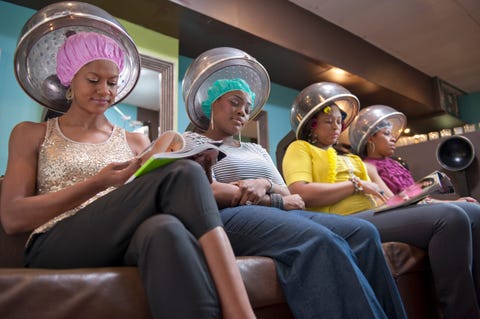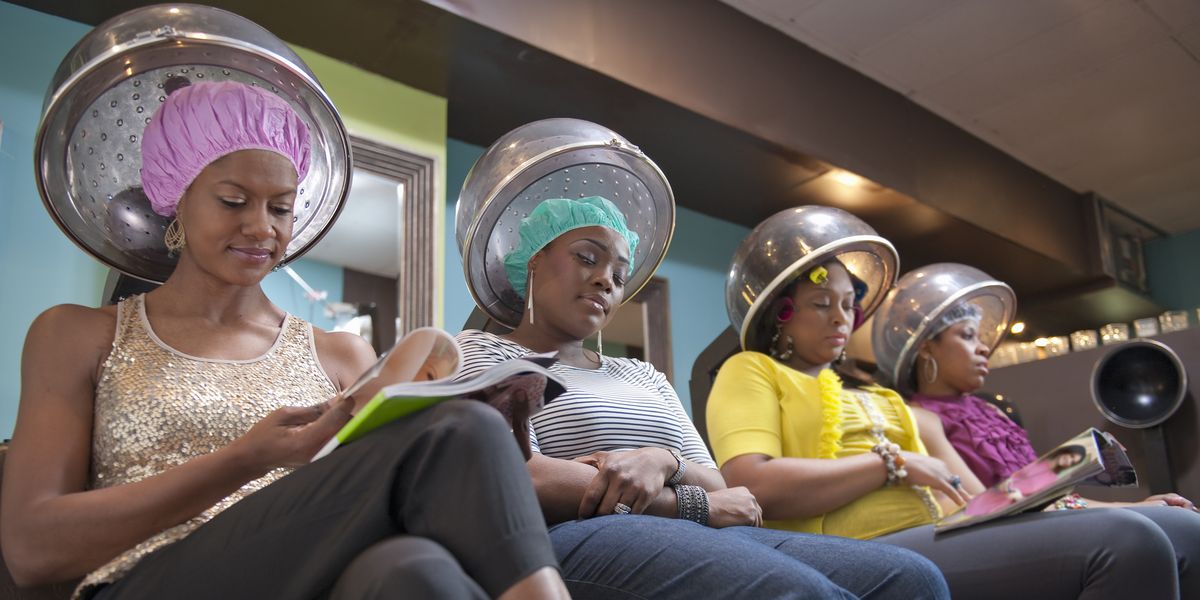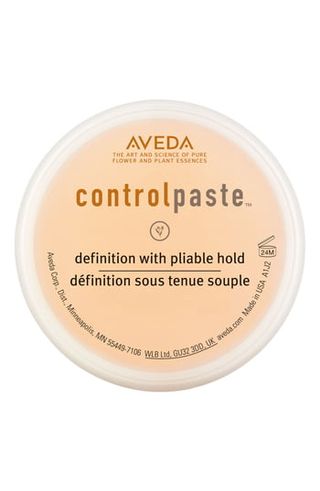
Yellow Dog ProductionsGetty Images
Before silk presses became the hairstyle du jour on the menu at natural hair salons, it was the press and curl that our mothers, aunts, and grandmothers did in our hair to prepare us for Easter Sunday, picture day, or our graduations. I can remember the process to this day: Sitting on a chair in the kitchen while the flames from the stove heat a rusty hot comb that had been passed down through generations; my hair sizzling as the hot comb gets combed through my slightly-greasy hair, then comes the loud “ouch” from the heat burning my scalp.
A press and curl was my first introduction to the notion that “beauty is pain”—relaxers followed suit—but the silk press is its healthier sister that aims to correct the damage the press and curl left behind.
The difference? “Tools,” Ebony Knight, founder, and CEO of Textured Press, an NYC based pop-up hair salon, tells ELLE.com over the phone. Growing up, our parents used the stove and a hot comb to straighten our hair; without knowing about the damage, we’d have to correct down the line. “A change in the times has brought us tools—flat iron and hot comb—that we can plug in to use as opposed to putting on the stove. Now, we have more control over the temperature.”
With salons steadily opening up, and people yearning for a new hairdo, you’ve probably considered running to your nearest salon for a silk press. Before you move, read everything you need to know about the hair process below.
Anyone can get a silk press.
Silk presses are not relegated to a particular hair type or thickness. But the outcome of the silk press tells you everything you need to know about your hair’s health. ” Does it have sheen? Does it have movement? Is your perimeter flourishing? All of those things come into play when it comes to your ‘typical silk press look,'” Knight explains. An important step when getting a silk press is a trim or a cut, so “the ends of your hair are not keeping you stagnant from experiencing movement and body of a silk press.”
What’s also important to consider your lifestyle. Frequent gym-goers are advised to skip the silk press process as silk presses temporarily straighten the hair, and sweat, water, and humidity can cause your hair to revert to its natural state.
Make sure the stylist of choice is knowledgable about hair care, not just styling.
Knight believes in asking the tough questions when searching for a hairstylist. “You want to ask the temperature they use on their flat iron. And the proper answer to that question would be that it depends on the texture and density of the clients’ hair. You want to know what heat protectant it is that they use. You want to know why. And if the answer that they give you makes you feel comfortable, then you continue searching until you feel comfortable putting your hair in someone’s hands,” she explains.
Trims and cuts are essential.
Knight advises discussing trims and cuts, as many stylists can get scissor happy when the point of a silk press is to provide silkiness, body, and length to naturally curly hair. This causes the frayed ends of your hair tend to cluster together, and that is going to make it so that your hair does not move or have any real bounce,” she says. The ends of the hair shaft is where you lose luster, and if the ends aren’t properly trimmed, your hair will “lose its sheen from the mid-point down to the end” and look dull.
Don’t get a silk press in the summer unless your lifestyle allows for it.
“The beauty of being natural is versatility—the curls, the texture, etc. And any drop of humidity is going to allow your hair to revert back, right? So if you are looking for that sleek look to last long, ideally, you wouldn’t want to get a silk press in the summer,” Knight explains. “But if you’re focused on length, then the summer is the ideal time to pull off that style because your hair is already stretched and cleansed. That’s the perfect time to do a twist-out, and a great way to take advantage of a silk press that’s kind of worn out. But all in all, the best time to do a silk press is going to be in the fall and the beginning of winter before it starts to snow.”
The Process Step-by-Step
- I start off by educating the client on their hair history. Then, I create a plan for the client to execute their hair care goals.
- Next, I shampoo, condition, and detangle the hair and allow the client to sit underneath a hooded dryer for anywhere between two to three minutes. (This way we pre-dry your scalp, so we don’t have to overwork your hair with a blow dryer.)
- To stretch the hair, I use a paddle brush and blow dryer to blow dry the rest of the hair.
- Finally, I’ll apply a heat protectant, and go into styling with the flat iron.
Be careful when touching up your silk press.
If your roots start to revert, it’s natural to want to touch it up yourself. While Knight suggests waiting for your stylist to do so, you can absolutely do it yourself. “Please be smart about it and use heat protectant,” she warns.
“You want to make sure that your iron is at a temperature that’s a little bit lower than what the stylist used because your hair is already straight. You also want to make sure you get at the root mostly when you go to touch up your press so you’re not damaging the part that’s already straight,” she adds. As for styling products that won’t cause your hair to curl back up, Knight suggests buying Aveda’s Control Paste, which keeps “the perimeter straight and not have that ‘crinkled wet look,’ and has a little bit of sheen or luster to it.” If you’re averse to shine and luster, Knight says She is Bomb’s Goo Gel works just as great. “Girl, when I tell you your edges will not move for three days, this product does just that without letting your hair to revert.”
This content is created and maintained by a third party, and imported onto this page to help users provide their email addresses. You may be able to find more information about this and similar content at piano.io


